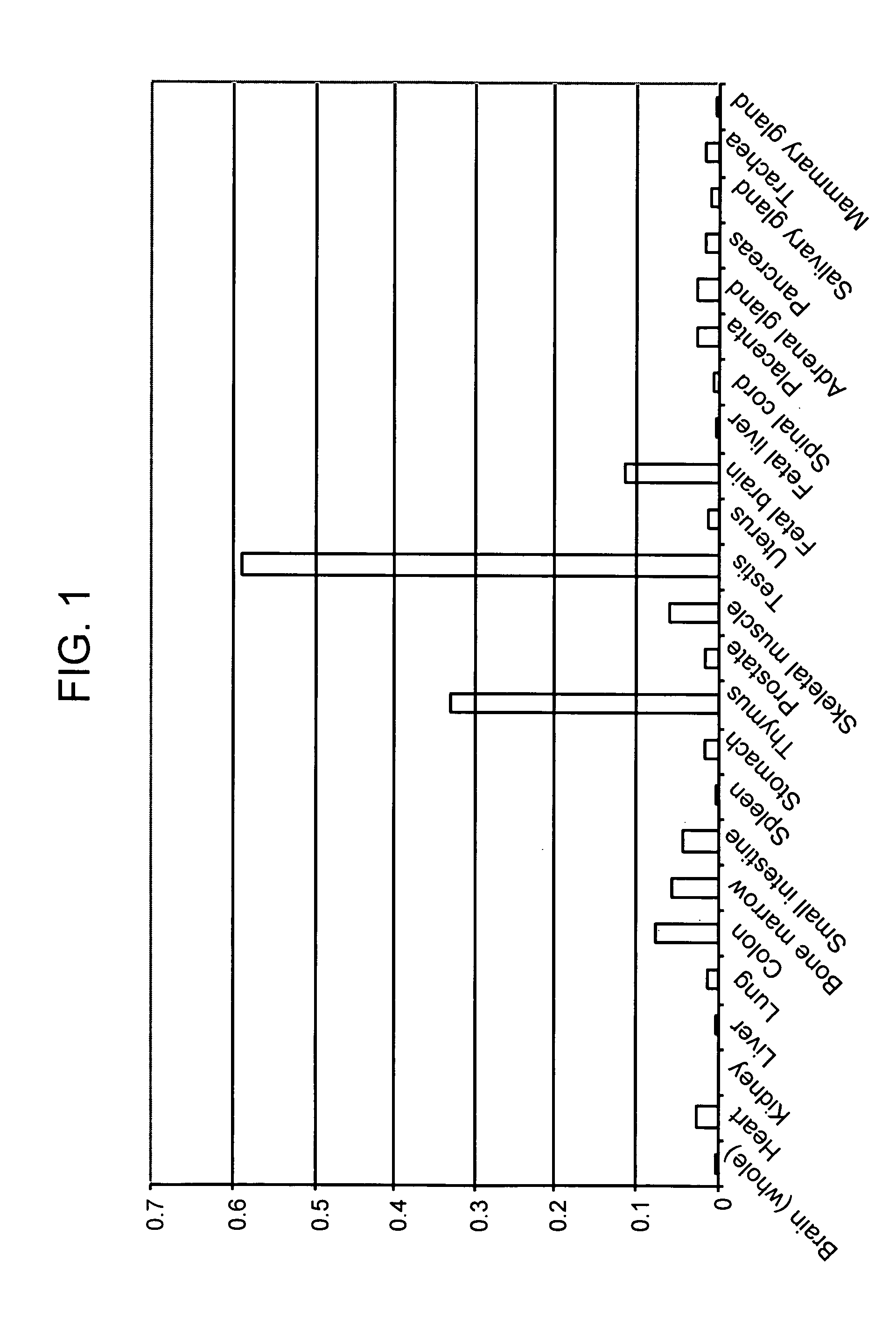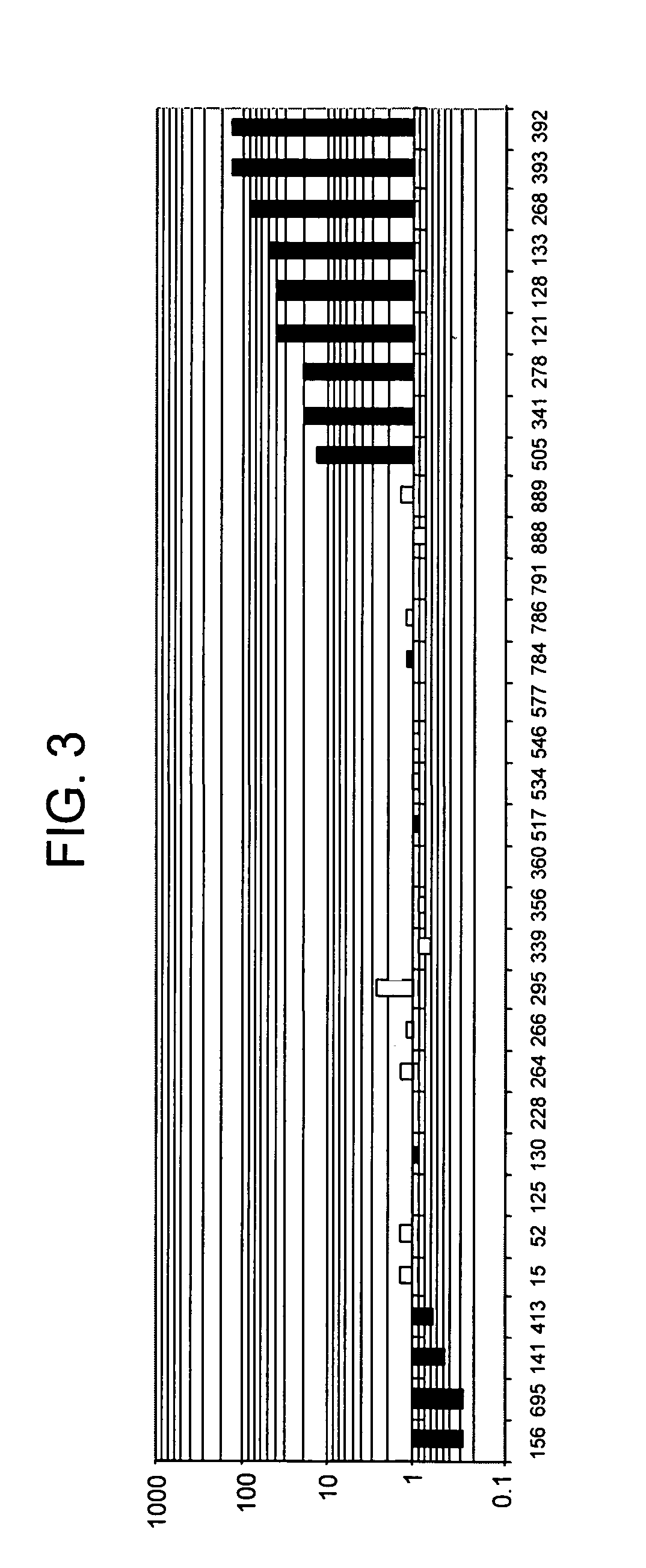HX2004-6 polypeptide expressed in cancerous cells
a cancerous cell and polypeptide technology, applied in the field of polynucleotides and polypeptides, to achieve the effect of facilitating cell identification
- Summary
- Abstract
- Description
- Claims
- Application Information
AI Technical Summary
Benefits of technology
Problems solved by technology
Method used
Image
Examples
example 1
Source of Patient Tissue Samples
[0647]Normal and cancerous tissues were collected from patients using laser capture microdissection (LCM) techniques, which techniques are well known in the art (see, e.g., Ohyama et al. (2000) Biotechniques 29:530-6; Curran et al. (2000) Mol. Pathol. 53:64-8; Suarez-Quian et al. (1999) Biotechniques 26:328-35; Simone et al. (1998) Trends Genet 14:272-6; Conia et al. (1997) J. Clin. Lab. Anal. 11:28-38; Emmert-Buck et al. (1996) Science 274:998-1001). Table 1 provides information about each patient from which the samples were isolated, including: the Patient ID and Path ReportID, numbers assigned to the patient and the pathology reports for identification purposes; the anatomical location of the tumor (AnatomicaLoc); The Primary Tumor Size; the Primary Tumor Grade; the Histopathologic Grade; a description of local sites to which the tumor had invaded (Local Invasion); the presence of lymph node metastases (Lymph Node Metastasis); incidence of lymph no...
example 2
Differential Expression of TTK
[0649]cDNA probes were prepared from total RNA isolated from the patient cells described in Example 1. Since LCM provides for the isolation of specific cell types to provide a substantially homogenous cell sample, this provided for a similarly pure RNA sample.
[0650]Total RNA was first reverse transcribed into cDNA using a primer containing a T7 RNA polymerase promoter, followed by second strand DNA synthesis. cDNA was then transcribed in vitro to produce antisense RNA using the T7 promoter-mediated expression (see, e.g., Luo et al. (1999) Nature Med 5:117-122), and the antisense RNA was then converted into cDNA. The second set of cDNAs were again transcribed in vitro, using the T7 promoter, to provide antisense RNA. Optionally, the RNA was again converted into cDNA, allowing for up to a third round of T7-mediated amplification to produce more antisense RNA. Thus the procedure provided for two or three rounds of in vitro transcription to produce the fina...
example 3
Hierarchical Clustering and Stratification of Colon Cancers Using Differential Expression Data
[0660]Differential expression patterns from Example 2 were analyzed by applying hierarchical clustering methods to the data sets (see Eisen et al. (1998) PNAS 95:14863-14868). In short, hierarchical clustering algorithms are based on the average-linkage method of Sokal and Michener (Sokal, R R & Michener, C D (1958) Univ. Kans. Sci. Bull. 38, 1409-1438), which was developed for clustering correlation matrixes. The object of this algorithm is to compute a dendrogram that assembles all elements into a single tree. For any set of n genes, an upper-diagonal similarity matrix is computed which contains similarity scores for all pairs of genes. The matrix is scanned to identify the highest value (representing a similar pair of genes). Using this technique, four groups of differential expression patterns were identified and assigned to clusters.
[0661]Application of hierarchical clustering to the d...
PUM
 Login to View More
Login to View More Abstract
Description
Claims
Application Information
 Login to View More
Login to View More - R&D
- Intellectual Property
- Life Sciences
- Materials
- Tech Scout
- Unparalleled Data Quality
- Higher Quality Content
- 60% Fewer Hallucinations
Browse by: Latest US Patents, China's latest patents, Technical Efficacy Thesaurus, Application Domain, Technology Topic, Popular Technical Reports.
© 2025 PatSnap. All rights reserved.Legal|Privacy policy|Modern Slavery Act Transparency Statement|Sitemap|About US| Contact US: help@patsnap.com



